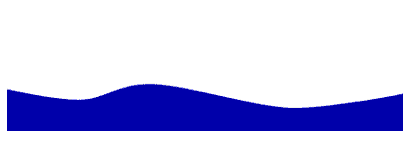

"Tsunami" is the Japanese word meaning tidal wave. A tidal wave is a large sea
wave caused by a submarine earthquake or volcanic explosion.When the ocean floor is tilted
or offset during an earthquake, a set of waves is created. These waves are similar to the
concentric waves generated by an object dropped into the water.
Usually tsunamis move entirely across an ocean to the shore. A tsunami
can have wavelengths of 60 to 120 mi and may reach speeds of 800 km/h. When the wave
enters shallow waters, the wave, which may have been half a meter high out at sea, grows
rapidly. When the wave reaches the shore, it may be 50 ft. high or more. Tsunamis have
incredible energy because of the great volume of water affected. They bring waves of
destruction capable of killing thousands of residents along the coast. Towering walls of
water have struck populated coastlines with such fury that entire towns have been
destroyed. In 1896 a population of 20,000 in Sanriku, Japan were wiped out. Tsunamis have
resulted in waves as high as 135 ft. above normal sea level.
When a tsunami strikes the shore, it creates a
number of waves with troughs that are lower than normal sea level. Each
following wave is higher than the one before it. The period between waves is 10 to 30
minutes. This usually gives people ample time to escape to high ground after the first
wave.
Most tsunamis originate along the Ring of Fire. The Ring of Fire is a
area of volcanoes and seismic activity 24,000 mi long. It encircles the Pacific Ocean.
Since the year 1819, more than 40 tsunamis have struck the Hawaiian Islands. A tsunami
warning system has been developed in areas such as Hawaii, where many devastating tidal
waves occur. Hawaii, the highest risk area, averages one tsunami every year with a
damaging occurrence every 7 years. Alaska, also at high risk, averages a tsunami every
1.75 years and a damaging event every 7 years. The warnings are provided by seismograph
records. Seismographs help determine the location of where a submarine earthquake occured.
These earthquakes usually originate in one of the deep trenches in the Pacific Ocean
floor.
One of the largest and most destructive
tsunamis ever recorded traveled at least half way around the world in 1883 after the
collapse of Krakatoa, a volcano in Indonesia. Waves up to 100 ft. high caused great damage
along the coast of Sumatra.
In 1964, an Alaskan earthquake generated a tsunami with waves between
10 and 20 feet high along parts of the California, Oregon, and Washington coasts. This
tsunami caused more than $84 million in damage in Alaska and 123 fatalities in Alaska,
Oregon, and California. Although tsunamis are rare along the Atlantic coastline, a severe
earthquake on November 18, 1929, in the Grand Banks of Newfoundland generated a tsunami
that caused considerable damage and loss of lives at Placentia Bay, Newfoundland. In 1946,
a tsunami with waves of 20 to 32 feet crashed into Hilo, Hawaii, flooding the downtown
area and killing 159 people. The Tsunami Warning Centers in Honolulu, Hawaii, and Palmer,
Alaska, monitor disturbances that trigger tsunamis. When a tsunamis is recorded, it is
tracked and a tsunami warning is issued to the threatened area. Most deaths during a
tsunami are a result of drowning. Associated risks include flooding, polluted water
supplies, and damaged gas lines. Since 1945, more people have been killed as a result than
as a direct result of an earthquake's groundshaking.